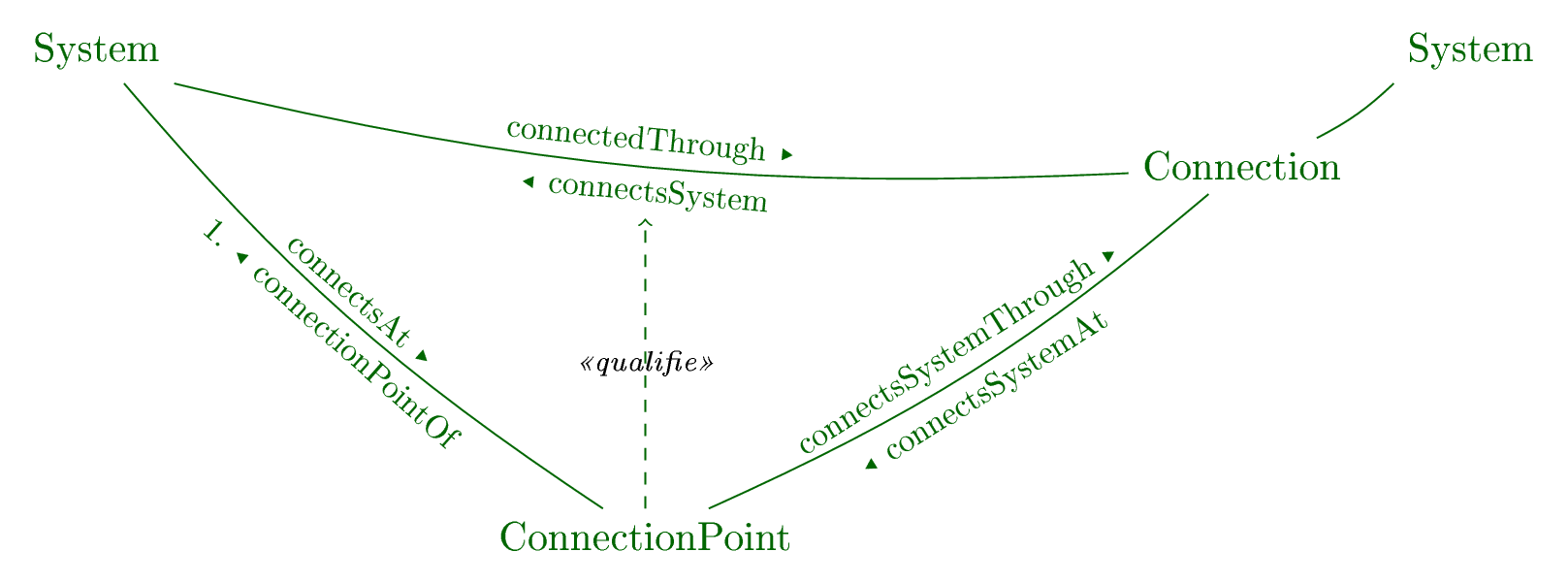The SEAS System ontology
The System Ontology defines Systems, Connections between systems, and Connection Points at which systems may be connected. This ontology is then specialized for multiple domains. For example:
- In electric energy:
- power systems consume, produce, store, and exchange electricity;
- power connections are where electricity flows between systems;
- power connection points are plugs, sockets, or power busses.
- In the electricity market:
- players and markets are systems;
- connections are contracts or transactions between two players, or between a player and a market;
- connection points include offers and bids.
Figure below provides an overwiew of the concepts in this ontology:
[](https://w3id.org/seas/system.png)
2016-06-06
seas
v1.1
2016-09-21
stable
The class of connections between systems.
This class qualifies property `seas:connectedTo`.
A connection describes potential interactions between systems.
For example, a power connection between power systems describes the fact that these systems may exchange electricity.
```
<connection> seas:connectsSystem <electric_vehicle> , <electric_vehicle_service_equipment> .
<electric_vehicle> seas:connectedThrough <connection> .
<electric_vehicle_service_equipment> seas:connectedThrough <connection> .
```
Any two connected systems are connected through a connection. If:
```
<system1> a seas:System .
<system2> a seas:System .
<system1> seas:connectedTo <system2> .
```
then there exists `_:connection` such that:
```
_:connection seas:connectsSystem <system1> , <system2> .
```
A connection can connect more than two systems at the same time.
Figure below illustrates connections of systems:
[](https://w3id.org/seas/system2.png)
Connection
testing
Evaluation of how the exterior contributes to the property.
Incoming evaluation
testing
Evaluation of how the property contributes to the exterior.
Outgoing Evaluation
stable
1
The class of connection points of systems, at which they may be connected to other systems.
This class qualifies properties `seas:connectsSystem` and `seas:connectedThrough`.
A connection point belongs to exactly one system.
For example, an electric vehicle service equipment may have three power connection points: two different kinds of plugs that enable to charge electric vehicles, and a three phase power bus connection point to the grid:
```
<electric_vehicle> seas:connectsAt <plug_high_voltage> , <normal_plug> , <three_phase_connection_point> .
```
Any system connected through a connection is connected at one of its connection points to the connection:
if:
```
<system> a seas:System .
<system> seas:connectedThrough <connection> .
<connection> a seas:Connection .
```
then there exists `_:connectionPoint` such that:
```
<system> seas:connectsAt _:connectionPoint .
_:connectionPoint seas:connectsSystemAt <connection> .
```
The system of a connection point that is connected through a connection is itself connected through the connection:. If:
```
<connection> a seas:Connection .
<system> a seas:System .
<connectionPoint> a seas:ConnectionPoint ;
<connectionPoint> seas:connectsSystemThrough <connection> .
```
then it is true that:
```
<connectionPoint> seas:connectionPointOf <system> .
```
Figure below illustrates connection points of systems:
[](https://w3id.org/seas/system3.png)
Connection Point
stable
The class of systems, i.e., systems virtually isolated from the environment, whose behaviour and interactions with the environment are modeled.
Systems can be connected to other systems. Connected systems interact in some ways. For example:
```
<electric_vehicle> seas:connectedTo <electric_vehicle_service_equipment> .
```
Systems can also have subsystems. Properties of subsystems somehow contribute to the properties of the supersystem. For example:
```
<battery> seas:subSystemOf <electric_vehicle> .
```
Figure below illustrates systems and their connections:
[](https://w3id.org/seas/system1.png)
System
stable
Links a system to one of its connections to other systems.
connected through
stable
Links a connection to one of the connection points at which it connects a system.
connects system at
stable
Links a connection to one of the systems it connects.
connects system
stable
Links a connection point to one of the connections through which it connects its system.
connects system through
stable
Links a system to a system it is connected to.
Connected systems interact in some way. The exact meaning of _interact_ is defined by sub properties of `seas:connectedTo`.
For example, for the electricity to directly flow between an electric vehicle service equipment and an electric vehicle, then they must be linked by property `seas:exchangesElectricityWith`:
```
seas:exchangesElectricityWith rdfs:subPropertyOf seas:connectedTo .
<electric_vehicle> seas:exchangesElectricityWith <electric_vehicle_service_equipment> .
```
Property `seas:connectedTo` is symmetric:
```
if x seas:connectedTo y, then it is true that y seas:connectedTo x.
```
This property can be qualified using class `seas:Connection`, which connects the two systems.
If there is a connection between several systems, then one may infer these systems are pairwise connected.
connected to
stable
Links a system to its super system.
Properties of subsystems somehow contribute to the properties of the super system. The exact meaning of _contribute_ is defined by sub properties of `seas:subSystemOf`.
For example, if a fridge is a subsystem of a kitchen, then its consumption power contributes to the consumption power of the kitchen.
Property `seas:subSystemOf` is functional, and should be asymmetric:
```
if x seas:subSystemOf y1 and x seas:subSystemOf y2, then y1 and y2 refer to the same resource.
if x seas:subSystemOf y, then it can't be the case that y seas:subSystemOf x.
```
The asymmetric aspect of property `seas:subSystemOf` would prevents a system from being its own sub-system. Unfortunately, OWL 2 DL disallow a non-simple property (e.g., a functional property) from being asymmetric, see OWL 2 Syntax section 11.
If it was possible that both the fridge and the kitchen be sub systems of a common super system, say, the house, then the consumption power of the fridge would contribute twice to the consumption power of the house. The functional aspect of property `seas:subSystemOf` prevents this undesired effect.
Due to the open world assumption of RDF, it is not possible to model the closed set of sub systems of a system using property `seas:subSystemOf`.
sub system of
stable
Links a connection point to the one and only one system it belongs to.
connection point to
stable
Links a system to one of the connection points at which it connects.
connects at
stable
Links a system to one of its sub systems.
has sub system
testing
Evaluation of the difference between the incoming evaluation and the outgoing evaluation.
Balance Evaluation